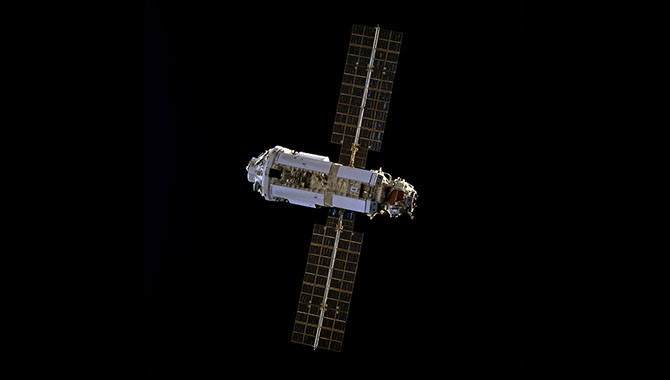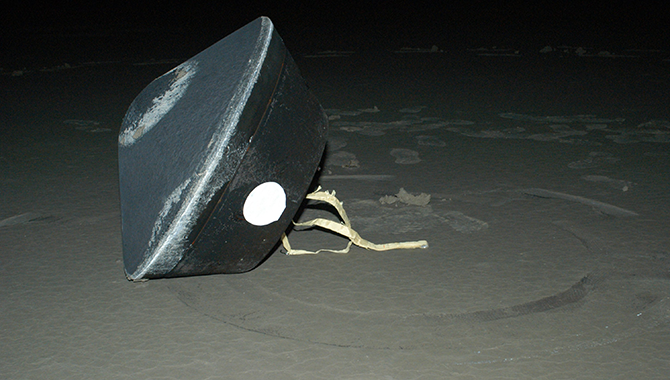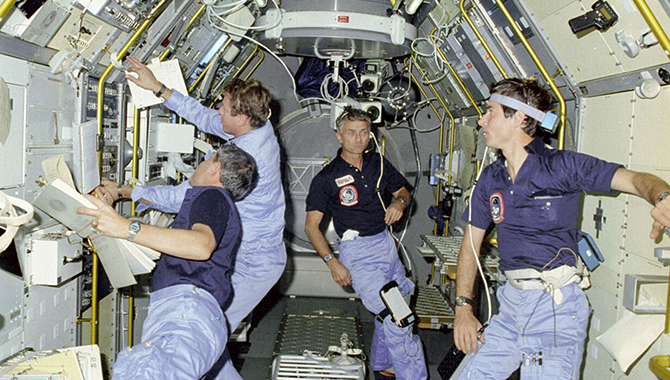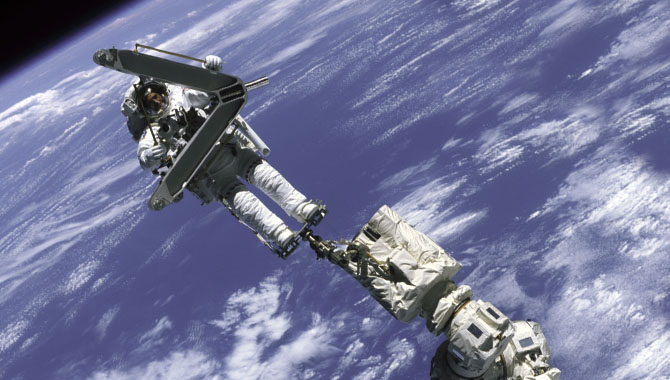
The Zarya control module was the first component of the ISS to reach orbit. It provided initial power, communications capabilities, and orientation control for the space station.
Photo Credit: NASA
On November 20, 1998, the Zarya module launched from Kazakhstan aboard a three-stage Proton rocket to form the cornerstone of the International Space Station (ISS).
Official impetus for the U.S. to establish a permanent station in space had come 14 years earlier. In a 1984 State of the Union Address, President Ronald Reagan said, “A space station will permit quantum leaps in our research in science, communications, and in metals and lifesaving medicines which could be manufactured only in space.”
He emphasized the importance of having international support for the station: “We want our friends to help us meet these challenges and share in their benefits. NASA will invite other countries to participate so we can strengthen peace, build prosperity, and expand freedom for all who share our goals.”
Several years later, the U.S. signed an agreement with Europe, Canada, and eventually Japan to develop a capability known as Space Station Freedom. That concept was never realized, as budgetary issues and other external concerns plagued the project. By the early-1990s, the Cold War had ended, the world had changed dramatically, and Russia indicated an interest in moving on from their proprietary station, Mir, to become part of the global partnership supporting the development of a new multi-national space station.
The first component of the ISS is the Zarya control module, also known as the Functional Energy Block, the Functional Cargo Block, and the FGB. Built in Russia but funded by the U.S., Zarya exemplified the spirit of international collaboration that is the hallmark of the ISS. Zarya was constructed by the Khrunichev State Research and Production Space Center in Moscow under subcontract to The Boeing Company for NASA. Following a design that was heavily influenced by Soviet Mir modules, construction of Zarya began in 1994. Upon completion, the module was shipped to Baikonur Cosmodrome, Kazakhstan, in January 1998 to begin preparations for launch.
Early on the morning of November 20, a Russian Proton rocket powered Zarya into its initial orbit roughly 250 miles above Earth. The launch was flawless. Once in orbit, Zarya’s systems were automatically activated and its solar arrays and communications antennae deployed. Days later, Zarya fired its engines to achieve a modified orbit, where the ISS still operates today.
Built to last at least 15 years—and still going strong—Zarya weighed in at 42,600 pounds. It is more than 41 feet long and 13.5 feet across at its widest. It has three docking ports. Two are permanently connected to other ISS components, while the third was designed to work with both Soyuz and Progress spacecraft. Zarya has two solar arrays, six nickel-cadmium batteries that can produce roughly three kilowatts of power, and 16 external fuel tanks that together hold six tons of propellant. Zarya is also equipped with 32 steering jets and two large engines.
The initial goal of Zarya was to provide orientation control, communications, and electrical power to the second component of the ISS: Unity, a U.S.-built element intended to meet Zarya on orbit in early December 1998. Eventually, a third component—the Russian-built Service Module Zvezda—would take over most of Zarya’s functions, leaving it to serve primarily as a storage facility.
Roughly two weeks after the launch of Zarya, on December 4, the Space Shuttle Endeavour left Kennedy Space Center (KSC) carrying the Unity module. On December 6, construction of the ISS commenced as Endeavour connected Unity to Zarya using the space shuttle’s 50-foot-long robotic arm. Several members of Endeavour’s crew—which included Commander Robert D. Cabana (now Director of KSC), Pilot Frederick W. Sturckow, and Mission Specialists Nancy J. Currie, Jerry L. Ross, James H. Newman, and Sergei K. Krikalev—performed extravehicular activities (EVAs) to complete the task. Eventually, the two modules were successfully powered up.
The arrival of the third component, Zvezda, was delayed until 2000. On November 2, 2000, nearly two years after Zarya reached orbit, the first ISS inhabitants arrived. Expedition 1 consisted of three men, NASA astronaut William Shepard and Russian cosmonauts Sergei Krikalev and Yuri Gidzenko, who were the first people to live and work on the ISS. They stayed for four months, marking the start of 15 years of continuous human presence—and remarkable international collaboration—on the space station.
Read an APPEL News article about the 15th anniversary of uninterrupted human habitation of the ISS.
Watch a video about the extraordinary accomplishment of constructing the ISS.
Go on a video tour, led by NASA astronaut Suni Williams, of the Zarya and Zvezda ISS modules as well as other parts of the Russian segment of the space station.
Listen to Johnson Space Center Deputy Director Mark Geyer talk about the early days of constructing the ISS, the launch of Zarya, and how those experiences have bearing on the current journey toward Mars.









